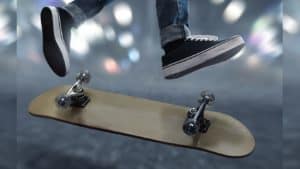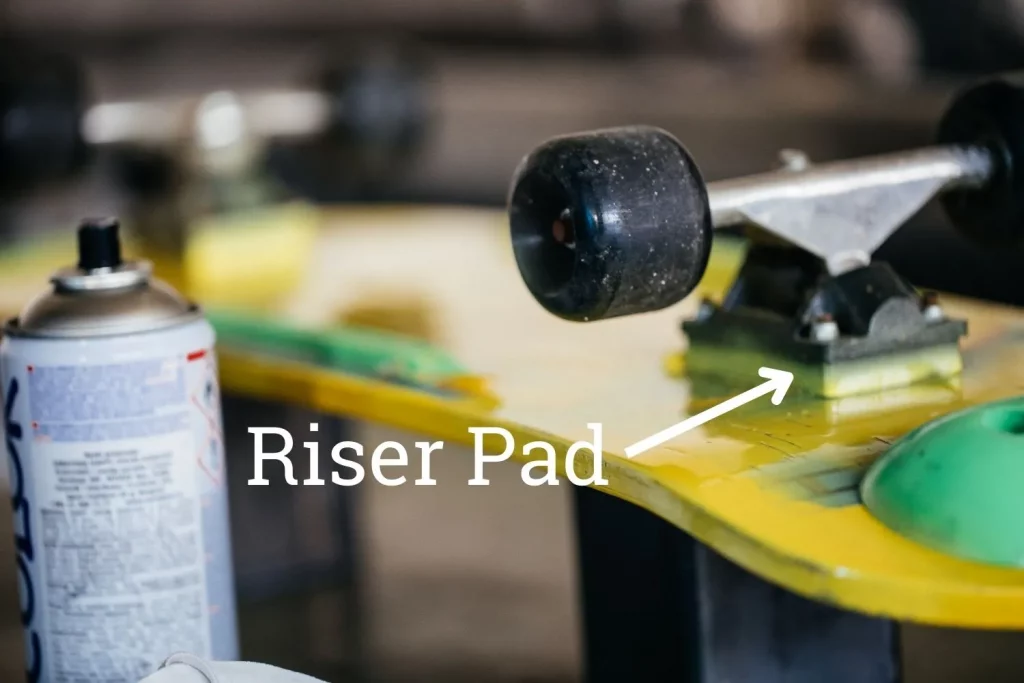
What is wheel bite on a skateboard | How To Prevent and Fix
- Ed Riley
- November 26, 2022
Skateboarding, currently an Olympic sport, is also a leisure pastime that involves riding a skateboard and executing tricks. To become a professional at this game, you must spend a lot of time learning and practicing on the skateboard. You will gain confidence in your sports and be able to overcome various hurdles with certain pro tricks.
During your learning period, you should also be aware of any obstacles that may impede your bright skateboarding career. Let’s talk about one such: wheel bites!
Wheel bite is one of the most common issues that every skater confronts throughout their career. It is almost unavoidable. However, with proper measures, the impact can be slowed down and reverted. Here we have discussed all about the ifs & hows of a wheel bite!
When the board comes into traction with one of the rims, pressing it against the ground, it stops moving. The sudden halt blocks the wheel circulation, causing you to lose your grip or tumble off. This is the situation when a wheel bite may happen.
Wheel bite is dangerous because it abruptly stops the wheel’s rotation, resulting in a serious blowout or harm to the rim and board. It can even cause serious injury to the skaters. So you must treat it as a matter of concern.
You will find wheel bite marks on the back of almost every skateboard that is being ridden for a while. Even if you take proper measures to avoid wheel bite, it’s still possible if you fall strongly on one side of the board. Your deck will grind against your wheels periodically if you apply enough effort.
If you get a wheel bite once or twice, don’t think too much about it because it was probably simply a fluke. However, if you’re suffering too much wheel bite during each skate session, it’s time to make some adjustments.
Several remedies are there for preventing wheel bite on a skateboard. There is no exact gap between the wheels and the deck that can prevent wheel biting. It is determined by how flexible your trucks are skated, how loose are your bushings, your mass, and the kind of skating.
We will see some easy methods then eventually the harder or more complicated ones. There are various methods for preventing skateboard wheel biting. Some of these strategies are more successful than others, but they will all come to help anyway.
Here are methods to avoid wheel bite:
Wax Under Wheels:
If you don’t want to modify anything else about your configuration, you might apply a small layer of wax or soap to the bottom of your deck. This will make the surface a little slicker and reduce friction between the wheel and the deck. However, if you have a serious wheel bite, this may not be a viable solution.
Consider installing rising pads:
Riser pads are required for skate wheels with diameters greater than 56mm. This is the most effective solution to your problem.
It is a rubber or plastic block that increases the gap between the skateboard wheels and deck. The greater gap amidst the deck and the wheels allow sharper turning. Shock pads are rubber made riser pads that protect against pressure fractures caused by forceful impacts.
We don’t recommend Skaters stressing over riser pads as it is not for conventional skateboarding and only pertains to cruisers and longboarders.
This table gives you whatever you need to know about riser pads and sizes:

| Wheel diameter (mm) | Riser pad size (inch) | 7-Ply deck Hardware length (inch) | 8-Ply or 9-Ply deck hardware length (inch) |
|---|---|---|---|
| 49mm – 54mm | No risers needed | 7⁄8″ | 1 1⁄8″ |
| 55mm – 56mm | No risers needed if your trucks are tight | 7⁄8″ | 1 1⁄8″ |
| 55mm – 56mm | 1⁄8″ with loose trucks | 1 1⁄8 – 1 1⁄4 | 1 1⁄4 – 1 1⁄2″ |
| 57mm – 58mm | 1⁄8″ | 1 1⁄8 – 1 1⁄4 | 1 1⁄4 – 1 1⁄2″ |
| 59mm – 60mm | 1⁄8″ – 1⁄4″ | 1 1⁄8″ – 1 1⁄4″ | 1 1⁄4″ – 1 1⁄2″ |
Thick riser pads provide greater space between the deck and ground . A 1/4′′ riser will alter your board stability, and a 2/4′′ riser makes tricks more difficult. Certain moves become difficult to land due to the center of gravity moving high. Thick riser pads are often used for cruising.
Adjust the skateboard trucks:
Adjusting the tightness of your skateboard trucks is the simplest way to avoid wheel bite. Loose trucks frequently cause wheel bites, which may be readily remedied by fastening the kingpin wacko with a handy skate tool.
The disadvantage of this strategy is that it lowers your skateboard responsiveness. Your turns will be resisted by the trucks. They will seem stiff in the beginning, but you will get used to it.
This does not always cure the issue, if your bushings are worn-out. Grind King trucks are responsive to turns and increasing the tightness does little impact. In this scenario, replace the bushings. Bushings are not costly, and numerous excellent alternatives will increase your skating ability.
Changing the bushings:
Even if your bushings are in good condition, the hardness of your bushing may be inappropriate for your weight or skating style. Tightening your trucks won’t make much difference in that case. You’ll get considerably more resistance in your trucks by changing your bushings.
The table will assist you to understand bushing toughness in proportion to your weight and skating style:
| Bushing Hardness | Best For | Truck Feel | Recommended Skater Weight |
|---|---|---|---|
| Soft Bushings (80a – 90a) | Skaters with a lower weight | Loose | Up To 140lbs |
| Medium Bushings (90a – 96a) | Conventional skateboarding & street skating | Moderately Tight | 140lbs – 190lbs |
| Hard Bushings (96a+) | Heavy skaters, skating big features | Tight | 190lbs+ |
If you weigh more than 220 pounds, you should select Bones bushings. Bushings efficiency wear-off over time. especially if you are big. If altering the tightness no longer works, it’s time to buy new ones.
Get smaller wheels:
Smaller wheels, regardless of configuration, provide more space between the deck and wheel, minimizing your chances of wheel bite. Using wheels of 51mm to 53mm diameter is best to lower wheel bite risk. You don’t necessarily have to buy the tiniest wheels. Different wheel sizes have a distinct impact on how you skate, so consider your skating style before upgrading your wheels.
Another thing, Smaller wheels accelerate fast but have a low top speed. Wheel diameter is the most important factor for speed. Bigger speed is effective for a faster pace. If you skate on a flat surface like the street, a narrower wheel will suffice.
A tiny wheel, conversely, is light and significantly simpler to do acrobatics with, making it an apparent alternative for preventing wheel bite. In this case, a 51mm – 53mm wheel is recommended.
When it comes to transitional skating, things change. Holding speed is essential for maintaining momentum when you turn. Maintaining that pace is much simpler with bigger wheels. In this scenario, moving to a smaller wheel isn’t worth the slower speed, despite having a lesser probability of wheel bite.
Install wheel wells on your deck :
Wheel wells lower your board without replacing wheels or installing riser pads. You won’t have to give up stability this way. You’ll have better controllability as the center of gravity lowers down.
Wheel wells are quite backdated, but they’re still popular on larger configurations, especially on cruisers. You just need the right equipment for this simple job.
Wheel wells on street skateboards are rather unusual as they are not ideal for flat terrain or street skating, but ideal for people who love to cruise and curve.
Bushings are the rubber(polyurethane) parts that surround the kingpin. They give the vehicle’s rebound; the harder the bushing, the more difficult it is to turn the truck. A softer bushing should be used if you are light. And if you’re a little bigger or want to ride downhill, you’ll need tougher bushing. Because there are so many various types of bushings available nowadays, it’s difficult to say which ones are ideal for you; our advice is to start with the standard bushings and experiment from there. Unless you are extremely light or heavy, a lighter / heavier bushing is recommended from the start.
Wheel bite happens when the skateboard rims establish contact with the base of the board, triggering the rider to lose balance and maybe tumble. So, what exactly causes wheel bite? Several things might lead to this issue.
To begin, ensure that your skateboard wheels are the suitable size for your deck. When you ride your skateboard, the wheels are more likely to make contact with the deck, which might create wheel bite. Next, the toughness of your wheels might have a role. Softer wheels grasp the skateboard deck’s surface better and prevent wheel bite.Lastly, riding on a difficult or uneven surface might increase your chances of getting a wheel bite.
You’ll be able to cruise and carve with confidence if you don’t get a wheel bite. Usually the more a skater collapses, the more they get a wheel bite. You may spin and dive as hard as you want without fear of your board collapsing. It gives you more courage and makes skateboarding a bit safer. It also enhances the durability and the lifespan of your board and wheels, saving your cash.
Normally, you can press the trucks down to check how far your rims can go without biting. Simply remove the roadside bushing and press it down with your hand. The riser height is perfect if the narrowest turning radius while you carve is not causing a wheel bite. Carefully & slowly make a curve so that if you have a wheel bite, you can quickly get off.
Wheel biting is a stressful experience. By following these guidelines properly, you can reduce your chances of getting a wheel bite and make your skating experience pleasurable.
You may prevent this problem and enjoy skating to the fullest by ensuring that your wheels are the perfect size and hardness for your skating style.
Skate Insider is a participant in the Amazon Services LLC Associates Program, an affiliate advertising program designed to provide a means for sites to earn advertising fees by advertising and linking to Amazon.com
